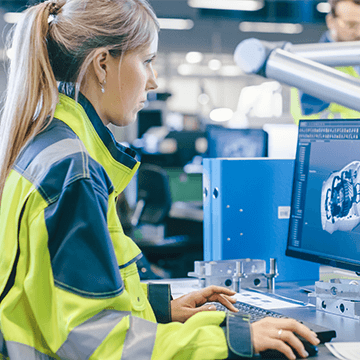- Solutions
- Products
- Community
- Resources
- Company
Create incredible candidate experiences that communicate your brand, mission, and values with recruitment marketing solutions.
Learn moreCommunicate effectively and efficiently with the candidates that can drive your business forward.
Learn moreSelect the right candidates to drive your business forward and simplify how you build winning, diverse teams.
Learn moreHelp your best internal talent connect to better opportunities and see new potential across your entire organization.
Learn moreCommunicate collectively with large groups of candidates and effectively tackle surges in hiring capacity.
Learn moreAccess tools that help your team create a more inclusive culture and propel your DEI program forward.
Learn moreRebound and respond to the new normal of retail with hiring systems that are agile enough to help you forge ahead.
Learn moreAccelerate the hiring of key talent to deliver point of care and support services that meet and exceed your promise of patient satisfaction.
Learn moreAttract and engage candidates with technical competencies, accelerate hiring for much-needed skills, and advance expertise within your valued workforce.
Learn moreSimplify how you recruit finance, insurance, and banking candidates with a unified platform built to match top talent with hard-to-fill roles.
Learn moreYour business strategy depends on your people strategy. Keep both in lockstep with the iCIMS Talent Cloud.
Learn moreBuild an engaging, high-converting talent pipeline that moves your business forward.
Learn moreDeliver the innovation your talent team needs, along with the global scale and security you demand.
Learn moreDeliver tailored technology experiences that delight users and power your talent transformation with the iCIMS Talent Cloud.
Learn moreThe #1 ATS in market share, our cloud-based recruiting software is built for both commercial and large, global employers.
Learn more Talk to salesAttract the best talent for your business with powerful, on-brand career websites that excite candidates and drive engagement.
Learn more Talk to salesCombine behavior-based marketing automation with AI insights to build talent pipelines, engage candidates with multi-channel marketing campaigns, and automatically surface the right talent for the job.
Learn more Talk to salesEmpower candidates with automated self-service, qualification screening, and interview scheduling through an AI-enabled digital assistant.
Learn more Talk to salesSimplify employee onboarding with automated processes that maximize engagement and accelerate productivity.
Learn more Talk to salesVerify skills with game-changing levels of automation and simplicity to improve the quality of hire at scale.
Learn more Talk to salesModernize, streamline, and accelerate your communication with candidates and employees.
Learn more Talk to salesTransform the talent experience by showcasing your authentic employer brand through employee-generated video testimonials.
Learn more Talk to salesSimplify recruiting, dynamically engage talent, and reduce hiring bias with job matching and recruiting chatbot technology.
Learn moreStreamline and centralize your HR tech stack with configurable, flexible, secure and reliable integrations.
Learn moreHow a beloved restaurant hires 40,000+ annually with a great candidate experience.
Learn moreThousands strong, our global community of talent professionals includes creatives, innovators, visionaries, and experts.
Learn moreTogether we’re creating the world’s largest ecosystem of integrated recruiting technologies.
Learn morePartner with our global professional services team to develop a winning strategy, build your team and manage change.
Learn moreExplore our network of more than 300 certified, trusted third-party service and advisory partners.
Learn moreUncover unique market insights, explore best practices and gain access to talent experts across out library of content.
Get resourcesExpert guidance about recruitment solutions, changes in the industry, and the future of talent.
Learn moreStay up to date with the latest terminology and verbiage in the HR software ecosystem.
Learn moreEmployers everywhere improve hiring efficiently and save money using iCIMS. Estimate the potential business value you can achieve.
Learn moreDive into the Class of 2023 Report highlighting this cohort’s expectations and where employers are willing — and able — to meet them.
Watch nowPartner with iCIMS to build the right strategies, processes, and experience to build a winning workforce.
Learn moreExpert guidance about recruitment solutions, changes in the industry, and the future of talent.
Learn moreDeliver the innovation your talent team needs, along with the global scale and security you demand.
Learn moreView press releases, media coverage, and the latest hiring data. See what analysts are saying about iCIMS.
Learn moreiCIMS is the Talent Cloud company that empowers organizations to attract, engage, hire, and advance the talent that builds a winning workforce.
Learn moreGet to know the award-winning leadership team shaping the future of the recruiting software industry.
Learn moreWe believe the future of work isn't something that "happens" to you. It's something you create. We actively create the future of work with our customers every day.
Learn moreiCIMS is committed to being a responsible and ethical corporate citizen, which is why Environmental, Social and Governance (ESG) initiatives are strategic imperatives.
Learn moreStreamline your tech stack and take advantage of a better user experience and stronger data governance with ADP and the iCIMS Talent Cloud.
Learn moreThe combined power of iCIMS and Infor helps organizations strategically align their business and talent objectives.
Learn moreOur award-winning partnership with Microsoft is grounded in a shared desire to transform the workplace and the hiring team experience.
Learn moreOur partnership with Ultimate Kronos Group (UKG) supports the entire talent lifecycle by bringing frictionless recruiting solutions to UKG Pro Onboarding.
Learn moreLet’s get in touch. Reach out to learn more about iCIMS products and services.
Learn more

More than 2 million U.S. manufacturing jobs may go unfilled by the year 2030, according to a report from Deloitte and The Manufacturing Institute. This future staffing crisis has its roots in the present. The industry maintained more than half a million job openings in 2023.
Manufacturing leaders feel this crisis acutely. In the 2023 Manufacturers’ Outlook Survey, 72% of manufacturers cited the inability to attract and retain employees as their primary challenge.
This challenge isn’t a new one. When the COVID pandemic hit, closures erased nearly 1.4 million manufacturing jobs in the U.S., “undoing more than a decade of manufacturing job gains,” according to Deloitte. The industry hired back 820,000 of those jobs by the final months of 2020. But the remaining employment gap persists.
The job openings created in 2020 will be augmented by industry growth and a retiring workforce. These two factors are expected to generate 4 million manufacturing jobs to be filled between 2020 and 2030. According to the Deloitte analysis, 1.9 million of these jobs are expected to be filled, leaving 2.1 million on the table.
The impact of this staffing challenge will be felt broadly. Should these jobs go unfilled, it could “bring a potential negative impact to the U.S. economy of more than $1 trillion by 2030 alone,” the report said. And as for the industry itself? Nearly 80% of executives said subpar staffing levels could have a moderate to very high impact on business outcomes such as production levels, development and innovation and rolling out new technology.
It’s no surprise, then, that manufacturers feel a sense of urgency when it comes to developing strategies to find and retain talent. The staffing issues they face today are predicted to grow much worse, and the challenges must be addressed now to prevent a crisis in the future.
To help attract and retain good workers, HR recruiters can leverage applicant tracking systems (ATS) to improve their perception among applicants, build their talent pools, assess applicants’ problem-solving skills and help hires advance in their careers.
The gap in manufacturing talent raises an important question for the industry: Why does it persist? The answer to this question is complex. There are several reasons why so many positions are going unfilled, according to a 2022 study from Deloitte and The Manufacturing Institute.
One of the most important reasons is a poor perception of manufacturing among potential workers. While perception has improved in the last decade, a limited understanding of the benefits of a manufacturing career may exacerbate the industry’s talent frustrations.
The study found that current manufacturing misperceptions largely stem from a lack of familiarity with the industry. For instance, 66% of respondents familiar with manufacturing said they believed that entry-level manufacturing gigs pay more than similar jobs in other industries. Only 34% of respondents unfamiliar with manufacturing said the same thing. A similar gap in perception existed between respondents familiar and unfamiliar with the industry when they were asked whether they thought manufacturing jobs were safe and clean, were stable career opportunities and were good opportunities for advancement.
The perception gap is causing real damage to manufacturers that are trying to get enough workers in the door. This challenge is true for entry-level positions, which require no technical skill or industry knowledge and are paid well above the federal minimum wage, Deloitte said.
But the challenge persists among more skilled roles, too. These positions often require hands-on experience and applied training, which can take months to complete.
As manufacturers battle perceptions misaligned with reality, they’re also grappling with a growing skills gap. According to a 2022 report from The Manufacturing Institute, manufacturers across every sector need three major skills to guarantee future success: data analytics, agile mindset, problem-solving and critical thinking and interpersonal skills.
Manufacturing employers are battling the double challenge of correcting widespread misperceptions and finding skilled talent. They need to tap strategies that speak to both of these issues — strategies that highlight what opportunities are available, what those opportunities look like, and how those opportunities might advance a job seeker’s career.
Video testimonials accomplish these tasks while keeping costs low and boosting employee morale. Informal footage of current employees mimics the short-form video content applicants see all over social media. In other words, it’s the kind of content that will actually get their attention.
These short videos will help viewers understand what it’s like to work a given manufacturing job. Manufacturers should make sure they highlight a variety of employees, taking the opportunity to demonstrate the diversity of talent within their workforce. This will help manufacturers attract more women, veterans and other underrepresented populations — a vital strategy in attracting more workers to fill the talent gap.
With tools such as iCIMS Video Studio, manufacturing employers can spotlight employees and mobilize brand ambassadors to share stories of workplace success and illustrate company culture. A skilled welder, for instance, may talk about what her daily life at work involves. She might discuss how she got her job and what she enjoys most about her post and her company.
Videos like this one can be used across social media and throughout marketing campaigns. They add intrigue and fascination to career sites, job descriptions and email and text campaigns.
Consider how the chemical company Celanese uses iCIMS Video Studio to create quick, unscripted and authentic content that helps job seekers feel connected to their mission, vision and values. With iCIMS Video Studio and other iCIMS tools, Celanese has boosted talent pool diversity by 77%.
As manufacturers boost their applicant numbers, they’ll want to consider adjusting their hiring processes to find the most skilled talent available. With prehire assessment tools, employers can find the talent that most aligns with the skill profile they need. More than half of organizations use prehire assessments to achieve high-volume hiring, according to a 2023 report from the HR Research Institute.
The key to these assessments, according to the report, is designing tests that are both fully compliant and nondiscriminatory and detailed so that they reveal the maximum amount of information about an applicant’s skill set.
In the manufacturing context, preemployment tests may help recruiters understand not only what technical skills an applicant possesses but also what soft skills they bring to the table. As one leader stated in The Manufacturing Institute’s report on the future of the industry’s skills gap, soft skills are indispensable to manufacturing. “Soft skills are vitally important to our business,” said the General Motors executive. “Manufacturing is a people business and we need leaders that can connect with people.”
Tools like iCIMS SkillSurvey go a step further than most preemployment assessments and use references to assess candidates’ hard and soft skills.
To grow and hone a robust talent pool of skilled applicants, manufacturers need tactics that make recruitment easy and effective. Marketing automation allows recruiters to build a pipeline of new and diverse talent by leveraging technology that nurtures candidates and automates recruiters’ workloads at the same time.
Automated emails are one of the hallmarks of recruitment marketing. As job seekers interact with a brand, automated emails that are personalized by lead score and activity customize their experience. For example, candidates who open an email with a new job alert can receive a second automated email with a prompt to get in touch with a recruiter.
Recruitment marketing tech also notifies recruiters when a lead is ready to move forward, saving them time and energy so they can spend it on what matters most — building relationships with excellent candidates and building out strategic plans that make their department stronger.
These tools also allow employers to keep passive talent engaged. With recruitment marketing tech, employers can cultivate a talent community comprised of job seekers who are interested in their brand but are not yet ready to come onboard. An automated newsletter will keep members up to date on company news, job opportunities and more.
Consider how Master Electronics used automated recruitment marketing tools to support mass hiring in its distribution center, which grew by 150% during the pandemic.
Manufacturers’ efforts to secure more skilled talent will be pointless if they aren’t paired with a robust framework to develop the skills of new and existing employees.
As an economist with the National Association of Manufacturers told trade publication Manufacturing Dive: “There’s no such thing as a low skilled job in manufacturing anymore … To really thrive, we’re going to need continuous learning and upskilling.”
Upskilling initiatives will not only help retain workers — they’ll attract talent who are invested in their careers and want to learn and grow in their profession.
This effort will also work to correct the perception gap plaguing manufacturing. According to the 2022 study by Deloitte and The Manufacturing Institute, 58% of respondents said they think manufacturing offers limited career prospects. Of these respondents, 81% said they would consider a manufacturing career if they saw clearer pathways for career progression. And 79% would do so if they received more personalized or customized training.
Employers that establish a culture of internal mobility will better showcase employment and growth opportunities. Within and outside the industry, there’s a growing trend toward developing internal talent, which is reflected in software tools. iCIMS Opportunity Marketplace not only attracts, engages and wins talent – it prioritizes internal mobility platforms as employers and employees grow.
From building a compelling employer brand to retaining and upskilling current staff, there’s a lot recruiters can do to find the manufacturing talent they need. Flexible, scalable hiring solutions play a big part. Learn more about recruiting software solutions for manufacturers here.


Alex is well-versed in content and digital marketing. He blends a passion for sharp, persuasive copy with creating intuitive user experiences on the web. A natural storyteller, Alex highlights customer successes and amplifies their best practices.
Alex earned his bachelor’s degree at Fairleigh Dickinson University before pursuing his master’s at Montclair State University. When not at work, Alex enjoys hiking, studying history and homebrewing beer.




